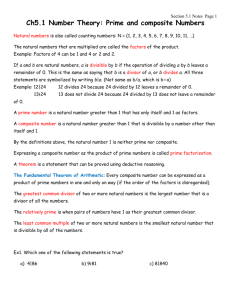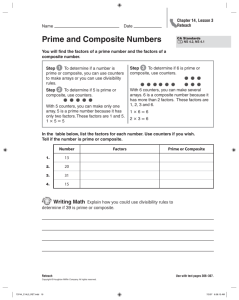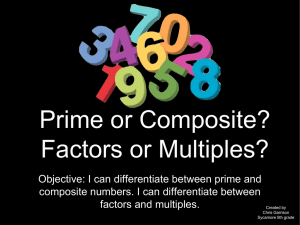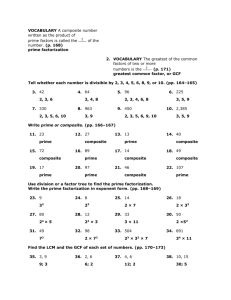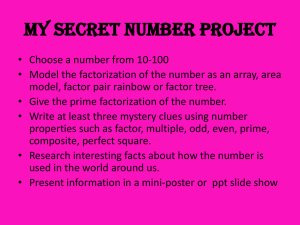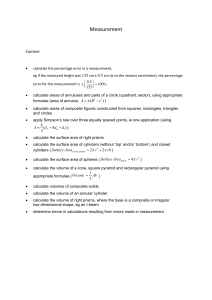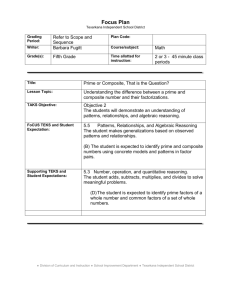4thGrade 4-8 - CSDElemMathSupport
advertisement
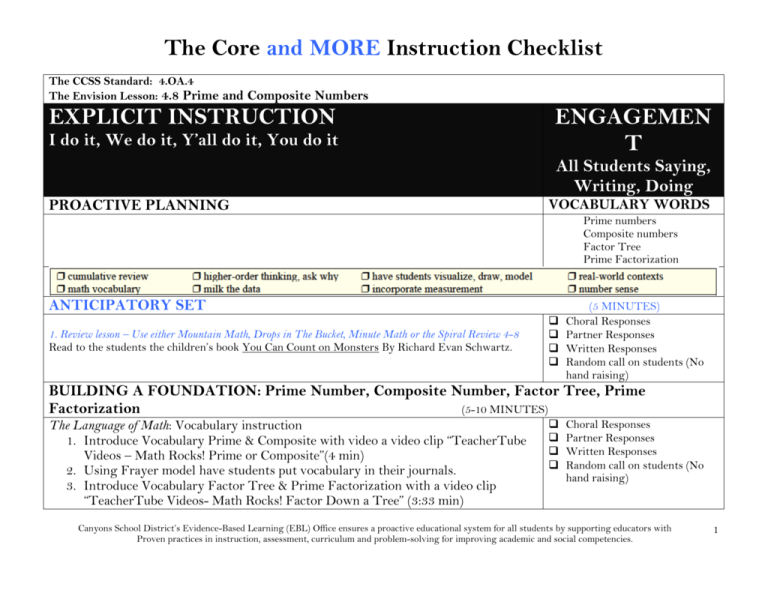
The Core and MORE Instruction Checklist The CCSS Standard: 4.OA.4 The Envision Lesson: 4.8 Prime and Composite Numbers EXPLICIT INSTRUCTION I do it, We do it, Y’all do it, You do it ENGAGEMEN T All Students Saying, Writing, Doing PROACTIVE PLANNING VOCABULARY WORDS Prime numbers Composite numbers Factor Tree Prime Factorization ANTICIPATORY SET 1. Review lesson – Use either Mountain Math, Drops in The Bucket, Minute Math or the Spiral Review 4-8 Read to the students the children’s book You Can Count on Monsters By Richard Evan Schwartz. (5 MINUTES) Choral Responses Partner Responses Written Responses Random call on students (No hand raising) BUILDING A FOUNDATION: Prime Number, Composite Number, Factor Tree, Prime Factorization (5-10 MINUTES) The Language of Math: Vocabulary instruction 1. Introduce Vocabulary Prime & Composite with video a video clip “TeacherTube Videos – Math Rocks! Prime or Composite”(4 min) 2. Using Frayer model have students put vocabulary in their journals. 3. Introduce Vocabulary Factor Tree & Prime Factorization with a video clip “TeacherTube Videos- Math Rocks! Factor Down a Tree” (3:33 min) Choral Responses Partner Responses Written Responses Random call on students (No hand raising) Canyons School District’s Evidence-Based Learning (EBL) Office ensures a proactive educational system for all students by supporting educators with Proven practices in instruction, assessment, curriculum and problem-solving for improving academic and social competencies. 1 4. Using Frayer model have students put vocabulary in their journals. 5. WHOLE GROUP INSTRUCTION: Concrete Develop the Concept: Interactive Learning (Hands-on) WHOLE GROUP 100’s charts – one for each student, one copy for you Blue/red crayon for each student 1. Model the chart as the whole class color-codes their 100’s chart; outline the prime numbers in red and the composite numbers in blue. 2. Glue the chart in their journal after their vocabulary words. SMALL GROUP Index cards with each of these numbers: Set 1: 24,3,8.2.4.2.2. Set 2: 24, 2,6,2,3. Set 3: 24, 4,6,2,2,2,3. Set 4: 36, 3,12,2,6,3,2,3. Set 4: 36,9,4,3,3,2,2. Set 6: 6,6,3,3,2,2. 1. Give one set of index cards to each of six teams. 2. Ask teams to create factor trees with their index cards. 3. Have teams with sets 1,2 & 3 compare, have teams with 4,5, & 6 compare their factor trees. 4. Record in their journal what they discovered in the sets they compared. Share with class SCAFFOLDED INSTRUCTION: Representational Develop the Concept: Visual 1. Share the Visual Learning Animation 4-08 (Do the Quiz attached to the learning animation having them record their answers in their journals as a quick check) 2. PAIR SHARE Refer to Investigations Unit 1, Investigation 1, pages 28-33 Building Arrays Centimeter Grid Paper (Resource Masters, M15, T13) one for each pair and one copy for you. Small slips of paper with a composite number on each slip, one slip per pair 1. Model Building Arrays. Ask students to give you one composite number between 4 and 20. 2. Brainstorm 2 factors for the composite number selected. 3. Project your graph paper and draw the array. Then brainstorm other possible arrays and draw them. 4. Model making an array with a Prime Number. Discuss the difference 5. Put students into pairs and give them the graph paper and the composite number paper. (10-15 MINUTES) Choral Responses Partner Responses Written Responses Paper Math Journal Individual Whiteboards Student page from the topic pouch Random call on students (No hand raising) (15-20 MINUTES) Choral Responses Partner Responses Written Responses Random call on students (No hand raising) Canyons School District’s Evidence-Based Learning (EBL) Office ensures a proactive educational system for all students by supporting educators with Proven practices in instruction, assessment, curriculum and problem-solving for improving academic and social competencies. 2 Have them draw at least 2 arrays using their Composite number. Share with class using document camera. 3. Guided/ Independent Practice 4-8 pgs. 106-107 Have students record problems and answers in their journals Time permitting assign problems from the Problem Solving page 108. INDEPENDENT PRACTICE: ABSTRACT Independent Practice and Problem Solving Interactive Learning Recording Sheet 9 – one for each student, one copy for you. 1. Refer to Problem-Based Interactive Learning activity on page 106B. 2. Model three numbers from the list with them. Suggest they have scratch paper to write out the factor tree for numbers they may struggle with. 3. Work independently, checking for accuracy. Any items not completed should be finished as homework. 4. The Chart will be glued into their journal on the next day. FORMATIVE ASSESSMENT (15-20 MINUTES) Choral Responses Partner Responses Written Responses Random call on students (No hand raising) (5-10 MINUTES) CENTER ACTIVITIES (15 - 45 MINUTES) *This part of the lesson is beneficial for providing engaging activities while the teacher works with small groups of students who need supplemental instruction. Students will need access to computers and page 109 Going Digital in Student Book. Students who master concept quickly can use the Spreadsheet/Data/Grapher etool located in the upper menu of the Student Edition online resource. HOMEWORK Complete the Factor Chart began during Independent Practice. Project a completed chart the next day and have them correct any numbers they have done incorrectly and then glue into their journal for reference. Canyons School District’s Evidence-Based Learning (EBL) Office ensures a proactive educational system for all students by supporting educators with Proven practices in instruction, assessment, curriculum and problem-solving for improving academic and social competencies. 3
